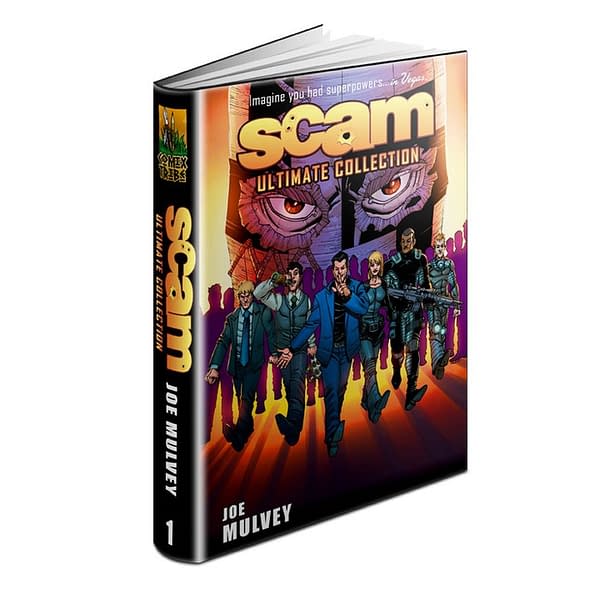Posted in: Comics | Tagged: advertising, Comics, entertainment, scam
Preaching On About Advertising and Comics – Some Strategies
I write comics. I also write ads for one of the largest agencies in the world – so it wasn't a huge surprise when Joe Mulvey called me to get my take on advertising and comics, for his article on Bleeding Cool last week.
It was even less of a surprise taking into account that Joe was kind enough to let me be a part of the Scam Ultimate Collection kickstarter, which gave me a chance to work with Joe Eisma, someone I'd dreamed of working with ever since I picked up Morning Glories #1.

The first, and largest, challenge in my opinion is the fact that the people you'd be trying to reach don't read comics regularly. It's just not a part of their routine – so you're trying to get them to pick up a new, unfamiliar behavior, and make it a part of their life – it's a far more challenging proposition than, say, advertising a new TV show – as most of the people you're talking to alrady watch TV, and its just a matter of them clicking over to your channel.
The second challenge is that comics are competing with a lot of different media – TV, movies, books and videogames are all places where people are already getting their storytelling fix. As a kicker, they're getting it more and more from characters that used to be exclusive to comics. Successful advertising would have to convince at least some people to take that ten bucks they were going to spend on a movie, and buy a couple of comics instead.
The third challenge has to do with one simple fact – advertising costs money, especially on a national scale. The players in the industry that actually have the money to do a national campaign have almost no incentive to do so, and the smaller companies and independent creators have margins that are thin enough to put most advertising options out of reach.
Distribution is another problem – being that if your closest comics shop is a 2 hour drive away, no advertisement on earth is going to get you to make that drive for a comic book, much less make it every week to get your pull list. Of all the problems on this list, that's the most easily solved, with mail order and digital, but it still bears mentioning.
So, what's the answer to all these big issues? It's obviously a different answer for Marvel or DC, than it would be for Image, or IDW, and a still different for smaller companies like Comixtribe. However, there are a couple of general strategies that can work no matter who we're talking about.
First off, as far as advertising goes, what matters more than how much money you spend, is how smartly you spend it. Whether you're talking a TV spot, a newspaper ad, all the way down to a single promoted tweet, you're looking for maximum exposure for the money you're putting in. So, if you're looking to being in potential readers, you need to look at where these readers might come from, and have a look at the sort of advertising they're encountering already.
If you're looking to talk to a certain group of people, look at what they like, and try to get in on it. Is there a band they like? Go hand out comics or digital codes at a show. Is there a website they go to? Put your ad money there, instead of just scattershot across the web. Ad rates on a very popular site might be out of reach – so you might look for similar sites that are more reasonable.
In essence, you need to find your target audience, and meet them halfway. By advertising to them, you're asking them to do something – to buy a book, and in the best case scenario, pick up a new hobby. The goal of your advertising should be to make that as easy as possible for them to do.
Which leads right into another strategy – when advertising comics to non-comics readers, you'll do a lot better emphasizing trades and GNs than individual issues. Picking up individual issues comes with lot of steps that can be tricky to maneuver for new readers. There's no easy, clear way to explain the Diamond ordering process, or why some comics double ship and some don't, or how all the Avengers titles fit together, except when they don't, in a single ad or communication. It's also not a great idea to sell someone on an unfinished story.
That model works for TV in the sense that you can get someone hooked for a season off of a single episode, but again, TV has the advantage of being very easy to access – once someone starts watching a show, they don't need to make a separate transaction every time they want to watch the new one (Ok, they do if they're watching it through Apple TV or something, but in general, if you want to watch, you just hit the button on the remote and watch).
For someone's first experience with comics, the goal should have them coming away feeling that they got a complete, satisfying experience – something that is more easily achieved by giving them a finished story.
As for the question of competing with other media, there's no real way for advertising to deal with that. That problem lies solely with the creators – who need to tell stories that can really show people why comics, as a medium, deserve to stand shoulder to shoulder with other forms of entertainment. We need stories with amazing art, mind-blowing concepts, and great stories.
The better the comics are, the easier it is for advertising to do its job, which is simply to get people to look at what you're selling. If you get people to look, and you have a great product, you'll get people to take a chance on it. Without it, though, all the advertising in the world won't do a thing.
Well, those are a few very general thoughts – if anyone wants to talk more specifically, you can hit me up on twitter – @rdouek
Be sure to check out the Scam Ultimate Collection, and even if you don't feel like pledging, please support it by spreading the word on twitter, facebook, or wherever you do your socializing. Word of mouth is the best advertising of all!
















